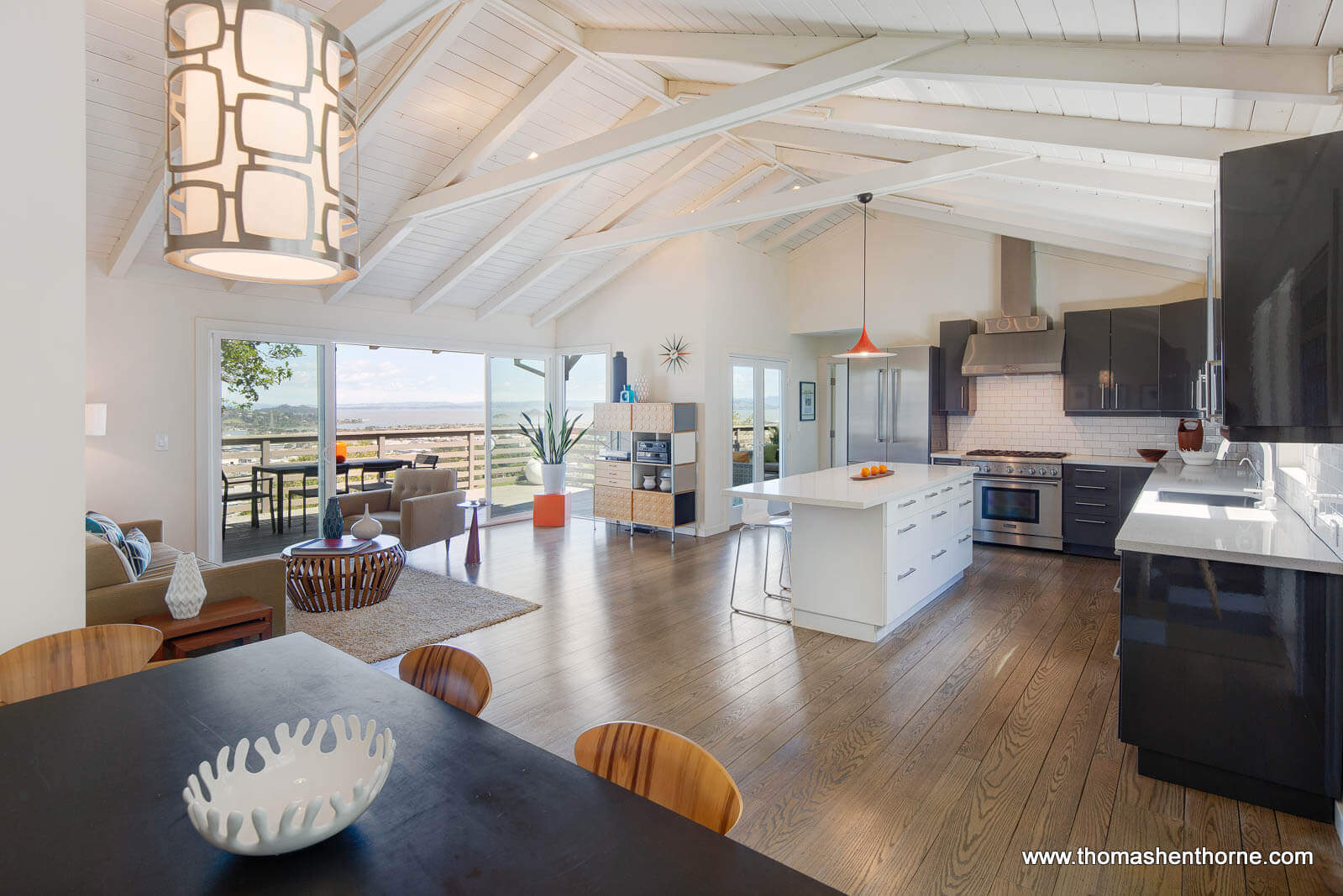Solar Energy in Marin County: My Own Experience
Solar Panel Advice from a Marin County Real Estate Agent
Several of my clients have asked me about installing solar panels on their home. When it comes to solar, there are many decisions – buy or lease? Which company to use? Where to place the panels? I thought I would share my own experience researching and installing solar panels on our home in Marin County.
Solar energy has been booming in California, fueled both by weather that in many places is ideal for solar generation, and by generous tax credits — currently 26% of the total cost of a solar system.
HEADS UP: The 30% investment tax credit (ITC) expired at the end of 2019 and has begun a stepdown process. The ITC is 26% in 2020, then 20% in 20201 and is slated to away completely in 2022. Please click here to read more.
There are two main reasons most people decide to “go solar”: to lessen their environmental footprint through the use of non-fossil fuels based energy, and to save money on their electric bill. Both are great reasons, and as you decide to install a solar energy system, there are some questions you will need to ask yourself, such as:
- How long do you plan to own your home?
- Are you comfortable with a larger up-front investment or would you like a smaller monthly payment?
- Do you view your solar energy system as an investment in your home or simply as a way to benefit the environment?
These will all help you make the first and probably largest decision you will face: buying your solar energy system vs. leasing it.
Buying vs. Leasing A Solar Energy System
If your main objective in installing a solar energy system is to benefit the environment, you might want to consider leasing a system. The main benefit of leasing a solar energy system is the lack of upfront costs. A solar leasing company will evaluate your electricity, determine the size system you need, then install and maintain it. You sign a contract promising to buy electricity from their system on your roof for a specified period of time, usually 20 years. Often this rate is set at market rates or just below, sometimes with provisions for increases during that 20 year period. In my own research, our bill would have stayed about the same, so the main advantage was the environmental benefit of moving to solar.
So what happens when it comes time to sell your home with a leased solar system? As a Marin real estate agent I face this issue frequently. The short answer is that in most if not all cases, the purchaser of your home must apply to assume the lease, undergoing a credit check and meeting other qualifications. It is critical you speak with the company about their policies prior to signing. Though you may not intend to sell, an unexpected life change may result in you needing to move. As indicated in this Washington Post article, buyers may balk at assuming the monthly leasing fees, or may not pass the credit check, and may ask you as the seller to spend upwards of $15,000 to buy out the system from the leasing company prior to close of escrow. Remember, when you are leasing, that company owns the panels on your roof and can remove them at any time should you fail to meet your obligations specified in the contract. In sum, a leased system can greatly complicate selling your home if the buyer is not willing or not able to assume the existing lease.
One of the reasons that solar energy leasing companies are so aggressive — meaning once they have your phone number you will likely receive repeated sales calls — is the model is highly profitable. The average solar system pays for itself in about 6 years, meaning that solar company is banking the profit for the remaining 14 years on your lease. And remember that federal tax credit? That also goes to the solar leasing company, because they are buying the system, not you.
Read my article about the pros and cons of leasing your solar panels here.
In my case, I decided to purchase a solar system. I view it as a home improvement / asset that should add value to my home if and when I sell it down the road, and in my case the system will pay for itself in about 5 years, meaning the next 15 years of its estimated lifespan I’m generating “free” energy.
The Steps Involved in Buying A System
The first step will be to research companies so you can begin obtaining bids on your system. In my case, I ended up using a company in Novato that unfortunately has gone through a lot of changes and I can no longer recommend. Solar installers in Marin are currently overwhelmed with business and I would recommend that you consult with friends and neighbors to find positive recent experiences.
Each company you speak with will want to obtain a copy of your last 12 months of electricity usage, something that’s easily done via the PG&E website. Once they have that, they will calculate the size system you need, and follow that up with a site visit to determine how to best arrange solar panels on your roof. Calculating the size system is critical as that will drive how long it will take your system to pay for itself. The bids for my solar energy system ranged from approximately $20,000 to $40,000…. the reason for that significant difference was that one of the companies decided I needed a system to cover all of my electricity usage.
Why would you want a system that only covers part of your usage? In California, the electricity rates currently are tiered 1-4, with tier 1 being the least expensive energy and tier 4 being the most expensive. My solar consultant explained that from an economic standpoint, you want a system that prevents you from moving into tier 3 and tier 4. The current rates for tiers 1 and 2 from PG&E are very reasonable and are less than what the cost per kilowatt hour is from a solar system. This hybrid approach shortens the payback period for your system and reduces the initial cost.
In my case, before solar energy my monthly electricity bill ranged from $150 to $350 depending on the time of year. Now I receive one annual electricity bill — called the “annual true up” — for about $300. Of course each month I continue to receive a bill from PG&E for natural gas usage and a small fee for connecting to the electricity grid.
As part of reviewing the bids, you will likely see various options — made in USA solar energy panels vs. panels made in other countries, one inverter vs. micro-inverters, etc. Your solar salesperson will be able to walk you through all the options. In my case I went with panels made in the United States and micro-inverters on each solar panel. The solar inverter converts the electricity from the panel to the type used in your home, referred to as “AC” or “alternating current.” If your system has one inverter, my understanding is the entire array (series of panels) stops generating when one panel moves into the shade. If you have microinverters on each panel, the remaining panels continue generating electricity even when one becomes shaded.
Solar Energy System Installation
Once you review the bids, negotiate (yes, they are negotiable!) and decide upon your installer, it’s time to schedule the installation date. In my case, I was leaving for an overseas trip and wanted the job done in 2 days. Solarcraft was able to schedule a double crew to get all the work completed in record time; however, the normal installation timeline is about a week for the solar contractors with whom I spoke. They handled all the paperwork and forms, such as submitting plans to the City of San Rafael Building Department and applying for our PG&E Interconnection Agreement.
Once the system is installed, it is tested briefly and then turned off. This is because PG&E has to review the interconnection agreement before you are permitted to throw the circuit breakers on your system and begin generating electricity. In our case, this took about a week to get the “green light” (pun intended) from PG&E to connect my solar system to the electricity grid.
Once connected to the grid, your electric meter runs backwards when you are producing more electricity than you are consuming. This means that you are actually adding electricity to California’s electric grid and you are receiving credits for this against your usage. These credits will be used in your annual “true up” when your usage for the prior 12 months is analyzed and a bill sent to you. Think of it like balancing a checkbook – with the pluses being your contributions to the electric grid and the minuses being the electricity you use from the grid.
Remember, the goal here is not to produce more solar energy than you consume on an annual basis — just to get you out of higher cost tiers 3 and 4. PG&E pays you the wholesale price for the excess electricity you generate — and that wholesale price is very inexpensive.
One final note: if your roof is not new, you might want to consider replacing it prior to installing a solar system. It is very expensive to remove a solar system, replace a roof, then re-install that system.
Solar Energy System Maintenance
Solar energy system maintenance is fairly minimal. Depending on conditions around your home, and how much rain we have had, you will want to get your solar panels cleaned once a year. The cost of this is approximately $500 and your solar provider will be able to tell by remotely monitoring your system if cleaning is needed or if there are other issues impacting solar energy generation. In addition, the inverter lasts about 10 years, so halfway through the expected 20 year life of your system you may need to replace it. Aside from that, there are no moving parts to break – your solar energy system just sits on your roof quietly generating electricity.

The Monitoring Display In My Laundry Room
Depending on the time of system that’s installed, you likely will have a monitoring panel in your home which sends generation and other data via the internet to your solar energy installer. In our case, this panel (pictured above is in our laundry room and provides a real-time readout of the amount of electricity currently being generated. This information is accessible on an app on my iPhone, so no matter where I am in the world I can see how much electricity my system is generating.

iPhone Monitoring App
I hope you have found this article interesting and helpful as you consider a solar energy system. Please subscribe to my blog below to receive email updates when I publish new articles about Marin real estate and Marin lifestyle. As always, I am available via phone / text at 415-847-5584 or the contact form below to answer any questions or help you with your real estate needs.
Please subscribe to my blog here:





